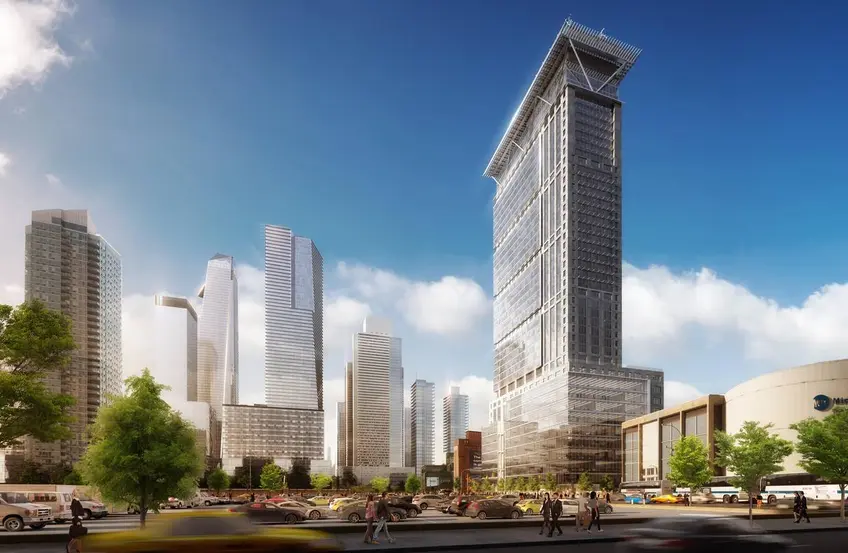 Rendering of 495 Eleventh Avenue designed by Davis Brody Bond Architects
Rendering of 495 Eleventh Avenue designed by Davis Brody Bond Architects
A proposed mixed-use skyscraper on Manhattan’s Far West Side is slowly moving through the city’s rigorous environmental review process. The city-owned lot at 495 Eleventh Avenue is currently used as an NYPD parking lot but if all goes according to plans, come 2023, the site will yield a 49-story, 560-foot tall tower composed of affordable housing units, dorm rooms, commercial office, and a supermarket.
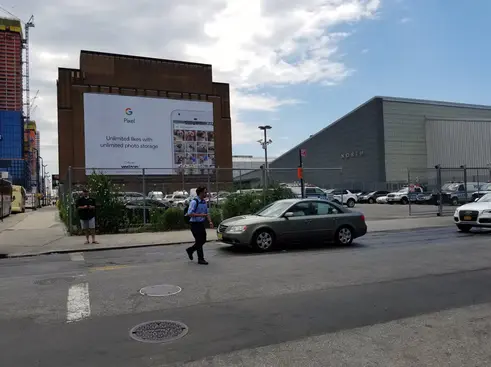 Existing 495 Eleventh Avenue site
Existing 495 Eleventh Avenue site
In this article:
The project site lies between West 39th and 40th streets, adjacent to the Javits Center and its ongoing expansion. Related/Oxford’s Hudson Yards plan is nearby, and a parade of skyscrapers are envisioned to rise along the length of Eleventh Avenue.
A 2015 RFP process led by the NYC Economic Development Corporation (NYCEDC) and the NYC Department of Housing Preservation & Development (NYC HPD) led to the selection of Radson Development with Kingspoint Heights Development as developers. The project is now moving through the city’s Uniform Land Use Review Proceadure (ULURP). Just last week, it was announced the project will have to prepare an Environmental Impact Statement (EIS) due to “the potential for adverse environmental impacts.”
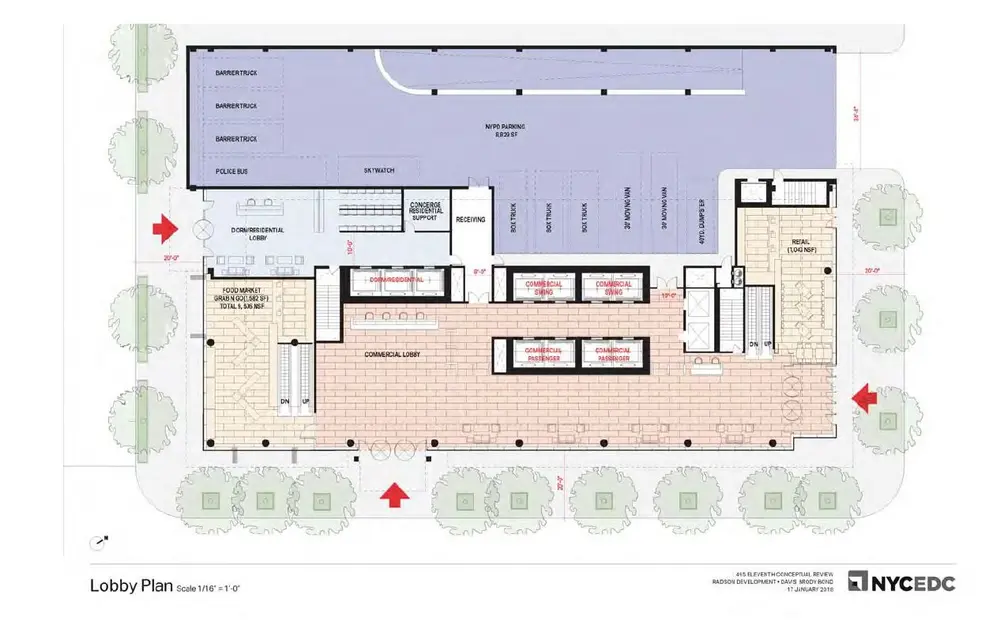 Schematic ground floor plan
Schematic ground floor plan
According to recently-published Draft Scope of Work for a Draft Environmental Impact Statement (DEIS), the chosen developers intend to build a 700,000-square-foot-tower with 234 affordable apartments, 88,000 square feet of dorm rooms, 200,000 square feet of office space and a 12,000-square-foot supermarket. Additionally, planned is 28,000 square feet of amenities that will include a health club, food court, and laundry facility. The NYPD is to reintroduce a parking facility to the building's cellar level and part of the ground floor. On the upper reaches of the tower, an urban garden, a cooling tower, and an alternative energy plant is envisioned. According to the DEIS, the completion is projected for 2023.
In a press release from May 2017, the now-Speaker of the New York City Council, Corey Johnson said, "This project will provide hundreds of families with affordable, high-quality housing in the heart of one of the most important neighborhoods in the United States. We must use every tool at our disposal to keep the West Side affordable to working and middle-class New Yorkers, and projects like this are key to helping us meet that challenge.
In a press release from May 2017, the now-Speaker of the New York City Council, Corey Johnson said, "This project will provide hundreds of families with affordable, high-quality housing in the heart of one of the most important neighborhoods in the United States. We must use every tool at our disposal to keep the West Side affordable to working and middle-class New Yorkers, and projects like this are key to helping us meet that challenge.
In a press release from May 2017, the now-Speaker of the New York City Council, Corey Johnson said, "This project will provide hundreds of families with affordable, high-quality housing in the heart of one of the most important neighborhoods in the United States. We must use every tool at our disposal to keep the West Side affordable to working and middle-class New Yorkers, and projects like this are key to helping us meet that challenge.
In a press release from May 2017, the now-Speaker of the New York City Council, Corey Johnson said, "This project will provide hundreds of families with affordable, high-quality housing in the heart of one of the most important neighborhoods in the United States. We must use every tool at our disposal to keep the West Side affordable to working and middle-class New Yorkers, and projects like this are key to helping us meet that challenge.
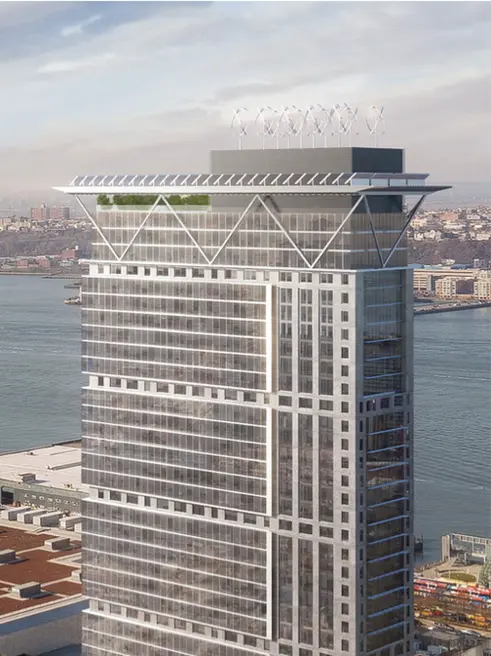 (BJH Advisors)
(BJH Advisors)
Long before Hudson Yards, the Far West Side was one of Manhattan’s great industrial centers, especially to businesses requiring the easy transport of large goods. Prior to the existing surface lot, 495 Eleventh was home to the New York Butchers’ Dressed Meat Company building Constructed in 1905 and designed by the architectural firm Horgan & Slattery, the dignified Neo Renaissance-styled building appeared to be something nobler than a slaughterhouse, that is until your eyes caught the six sizeable sculptures (weighing about a ton each) of rams and steers standing along the sixth-floor roofline.
According to a New York Times article by Christopher Gray, the building had a roof garden for livestock, which offered a bit of serenity to the animals before they moved to the killing floor the next level down. The railhead slaughterhouses lost their leg up with the advent of trucking. The city acquired the building in 1975 and demolished the structure in the late 1980s with the hopes of leasing the site to an office developer.
According to a New York Times article by Christopher Gray, the building had a roof garden for livestock, which offered a bit of serenity to the animals before they moved to the killing floor the next level down. The railhead slaughterhouses lost their leg up with the advent of trucking. The city acquired the building in 1975 and demolished the structure in the late 1980s with the hopes of leasing the site to an office developer.
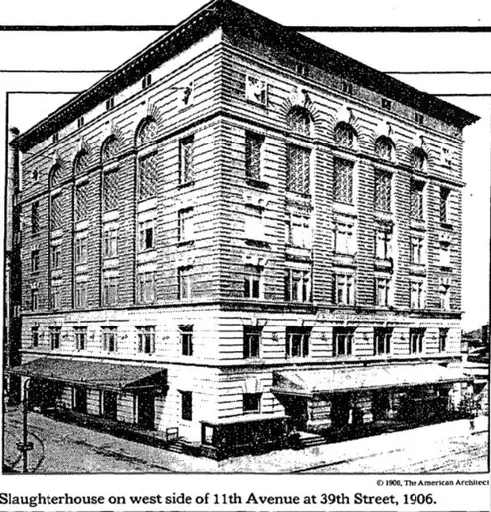 via New York Times
via New York Times


 6sqft delivers the latest on real estate, architecture, and design, straight from New York City.
6sqft delivers the latest on real estate, architecture, and design, straight from New York City.
